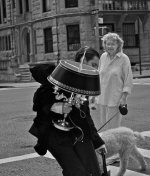Sonnar2
Well-known
There is an error in presumption here. Lenses with the lowest contrast showing NO details in the shadows, because the optical aberrations resulting in low contrast blanket fine details and toning difference. The same goes with flare. flare ruins the shadows, turning them to grey.
So for landscapes, low contrast lenses are next to useless.
You need at least a medium contrast/ high resolution lens to see details in the shadows. But it also depends on type of film and development. On the opposite side, a very high contrast lens (such as the newest ASPH. Leica lenses) can show so much details and deep (black) shadows that it may overburden the chain of reproduction, at paper, at electronic sensor, and even (which bears the most contast range) film.
Try a Summar wide open and see yourself.
So for landscapes, low contrast lenses are next to useless.
You need at least a medium contrast/ high resolution lens to see details in the shadows. But it also depends on type of film and development. On the opposite side, a very high contrast lens (such as the newest ASPH. Leica lenses) can show so much details and deep (black) shadows that it may overburden the chain of reproduction, at paper, at electronic sensor, and even (which bears the most contast range) film.
Try a Summar wide open and see yourself.
Last edited:








